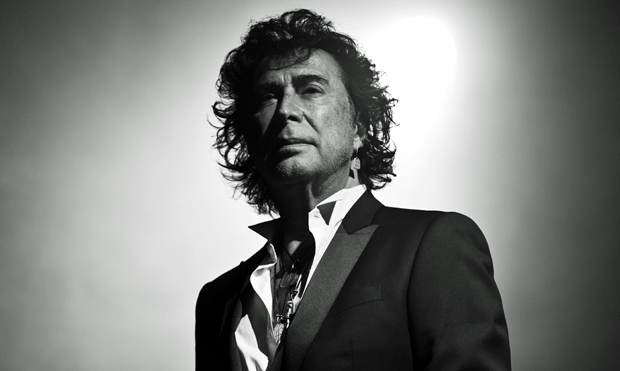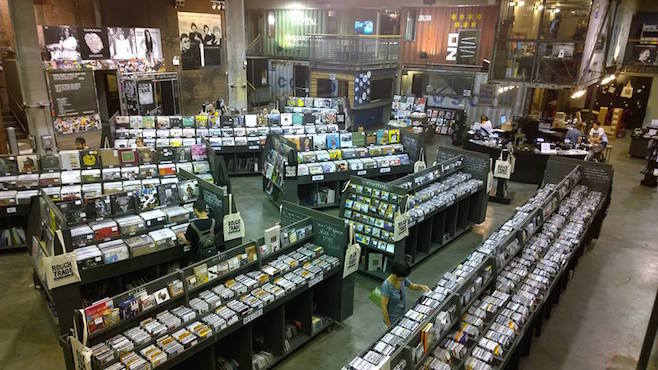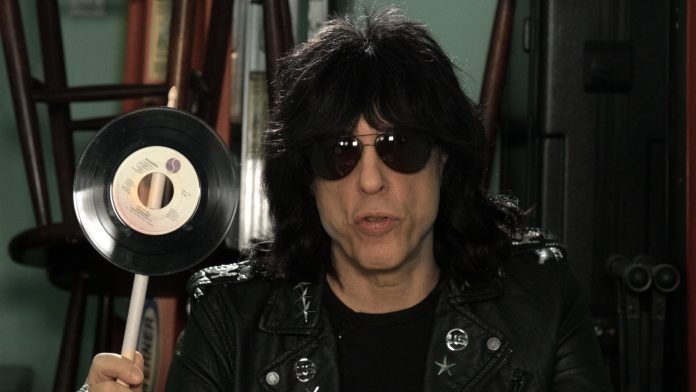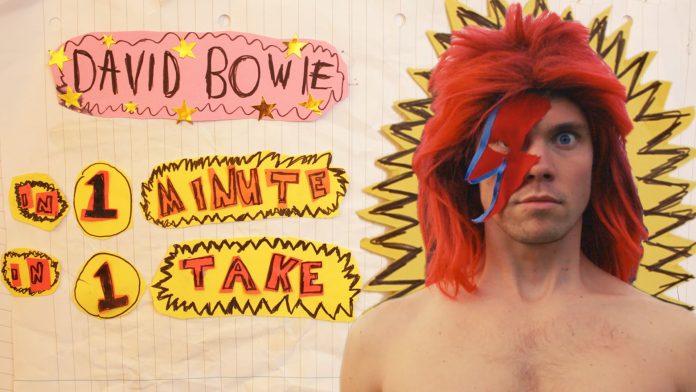Blake J. Harris from Press The Buttons has offered up a very cool look at the inside of the official Nintendo Character Manual from 1993 that features details for “any public performance of the Mario character” and more. There are lots of fun facts about classic Nintendo heroes and villains such as Yoshi’s real name (T. Yoshisaur Munchakoopas) and mushroom retainer Toad’s original hometown (he has family in the Fungus Federation).
Andy Kim Gets It Right When It Comes To Not Having Any Regrets
Andy, your career has stretched over decades, and you’ve been involved in so much pop iconography its sometimes hard to digest. So for you, looking back on everything that you’ve done, what has been your biggest regret, and, conversely, what has been your proudest accomplishment?
Andy Kim: I have no regrets. I have not one single regret. I was born with a wonderful DNA where I felt that my life was not a race against someone else or another artist. It was probably internal, ya know? I needed to this. I didn’t know why and I didn’t understand. I don’t come from a musical family and didn’t go to Julliard or anything, but I had this kind of vision of stuff that was so powerful that I just needed to find it. I have no regrets. There are times when, for many years, I’ve been irrelevant—and it was OK! I had my moment. No one is responsible for anyone else’s dreams. I don’t need a babysitter. I just needed to know that I could do this. I just think that my happiest time or my best time, upon reflection, is that I had the courage to do this. I had the courage to go to an environment that was the Brill Building and was actually welcomed but I had the courage to take this step.
Via Pop Matters
Calgary to Host the 2016 JUNO Awards
The JUNO Awards “road trip” is saddled up and heading west as The Canadian Academy of Recording Arts and Sciences (CARAS) and broadcast partner CTV announced today that Calgary will host The 2016 JUNO Awards and JUNO Week celebrations, March 28-April 3. The 45th annual JUNO Awards will be broadcast on CTV from The Scotiabank Saddledome on Sunday, April 3, 2016.
JUNO Week 2016 will bring the festivities back to Alberta following a community-based bid led by Tourism Calgary. The JUNO Awards are returning to Calgary after the outstanding success of the 2008 JUNO Awards, and this will be the city’s second time hosting Canada’s music awards.
“Calgary’s unparalleled enthusiasm and famous hospitality make it the ultimate host for Canada’s Music Awards,” said Allan Reid, President & CEO, CARAS/The JUNO Awards. “The city’s musical talent and passionate fans have only heightened the success of Canadian music and we are excited for what’s in store when we return in 2016 to celebrate the 45th annual JUNO Awards.”
“The JUNO Awards not only celebrate the best in emerging and established Canadian music, they shine a national spotlight on the host city,” said Phil King, President – CTV, Sports, and Entertainment Programming. “CTV looks forward to returning to Calgary with THE 2016 JUNO AWARDS broadcast, and sharing the undeniable energy of the city with viewers from coast-to-coast-to-coast.”
“I’m thrilled Calgarians will once again be hosting the JUNO Awards,” said Calgary Mayor Naheed Nenshi. “This is a tremendous opportunity for Calgary and our music and culture scene.”
“We’re delighted that the JUNO Awards will be returning to Calgary for the first time in eight years,” said Cindy Ady, CEO of Tourism Calgary. “2016 will be a great year for music in Calgary as we highlight Canada’s best musical talents during JUNO Week, followed by the opening of the highly anticipated National Music Centre later in the year.”
On the heels of being named the 2014 World Mayor by the City Mayors Foundation, Calgary’s Naheed Nenshi will be in attendance at next month’s JUNO Awards in Hamilton.
Alberta’s largest city and Canada’s third largest municipality, Calgary is home to major attractions like the Calgary Stampede (July) and the Calgary Zoo, as well professional sports teams like the NHL’s Calgary Flames and the CFL’s Calgary Stampeders. The city is known for its genuine hospitality and uncommon energy – a place where people from around the world come to experience adventure, rich Western heritage and pioneering traditions. Close to the Rocky Mountains and places like Canmore, Banff, and Lake Louise, Calgary straddles some of Canada’s most scenic landscapes, and is also home to an impressive range of talent and an increasingly vibrant arts and music scene. 2015 JUNO Award nominees from Calgary include Chad VanGaalen (Alternative Album of the Year*), Jann Arden (Adult Contemporary Album of the Year) and Kiesza (Single of the Year, Breakthrough Artist of the Year*, Dance Recording of the Year, Video of the Year*).
From 2007 to 2014 the JUNO Awards have created a total economic impact of almost $88 million, including $11.3 million for the 2008 JUNO Awards in Calgary, $14 million for the 2011 JUNO Awards in Toronto, and $10 million for the 2013 JUNO Awards in Regina.
Since CTV first partnered with CARAS in 2002, the JUNO Awards have travelled city to city across Canada starting in St. John’s (and again in 2010), followed by Ottawa (2003 and 2012), Edmonton (2004), Winnipeg (2005 and 2014), Halifax (2006), Saskatoon (2007), Calgary (2008), Vancouver (2009), Toronto (2011), Regina (2013), and this year in Hamilton.
Sharon Van Etten Gets It Right On Her Rules For Life And Music
Sometimes expressing emotions without holding back at all can be hard, because vulnerability can carry a stigma of weakness. Was that something that ever crossed your mind when it came to sharing your music?
Growing up, sharing how I felt and being vulnerable was considered a strength. It was something that I wasn’t good at for so long, that when I finally learned how to do it, I realized that I felt better and the people I was trying to communicate with felt better, as well. It’s something I’m still working on. Even when it’s hard, when people know how you feel, there’s no room for misinterpretation or misconnection. It’s important to be connected with people. It’s important for the people you’re close to to know who you are. If you shut any side of yourself down, especially that vulnerable side, which is where a lot of love comes from, it’s unhealthy. It is misconstrued as being weak, but that’s a militant upbringing. You’re told not to cry, to walk it off, but it’s OK to acknowledge and embrace pain—and share it. It can be really cathartic and positive.
At one point in your life, you were in a long-term relationship with someone who was extremely unsupportive of your music and your art. How does someone keep making their art when a person they care about in their life doesn’t want them to make it?
It was unbelievable that I even went on as long as I did. There was this driving force inside of me that felt [music] was important for me to do, that it felt good to do. For someone I cared about so deeply to not accept this part of me, like everything else about me was fine except for this one part, that’s not somebody loving you. I realized that I knew who my real friends and my family were, and what unconditional love meant: Where, even when it’s not easy, you accept it and you’re open to it. It just wasn’t love, so I didn’t keep that person in my life. Life is too short to surround yourself with people who aren’t looking out for you.
Via Rookie Magazine
Viewpoint by Frances Moore on the benefits of Global Release Day
According to a statement from the International Federation of the Phonographic Industry (IFPI), which represents labels worldwide, a study found that a majority of consumers who bother to care which day new music comes out prefer to hear it on Fridays and Saturdays.
“Music fans live in the digital world of today,” wrote IFPI head Frances Moore. Read below his statement in full.
After many months of discussions with groups across the music sector, today we are announcing an important milestone for our whole sector – the plan to implement an aligned global release day.
The concept has been long in preparation, and long in consultation. Since last summer IFPI has been a forum for monthly meetings with groups representing retailers, record companies, artists and musicians’ unions. We have looked at the different conditions and at a swathe of research and insight across international markets. Now we’ve reached the point where we can move ahead. There is a tremendous amount of support, from retailers, labels and artists. The list of supportive quotes, from Paul McGowan at HMV to Crispin Hunt at the Featured Artists Coalition, from Ken Parks at Spotify to Francesco Riganti at Mondadori Retail in Italy, gives just a snapshot of this.
Crispin Hunt of the Featured Artists Coalition (FAC)
“The FAC applauds the IFPI for involving the Artist Community in the development of this initiative. The FAC supports a Global Release Day as a great opportunity to re-engage the public with new music and re-ignite excitement around new releases. We are in a time when the general public’s involvement with music has become more fleeting and somehow less social – a global release day could help change that. As the weekend is when the public are most engaged with music and offers the best opportunity for musicians to access their audience, we believe a Friday release would best serve the artist and the fan, and help to make new music the occasion it should be.”
Paul McGowan, chief executive of Hilco Capital, the group which owns HMV
“A global release day is a totally logical move in today’s global music market and Friday is overwhelmingly the right choice for the day. Quite simply, new music should hit the high street when people hit the street. New Music Fridays will get new releases to fans when they most want to buy them. As the UK’s biggest music retailer, that makes perfect sense to us.”
Frances Moore, chief executive, IFPI
“A global release day makes sense for one overwhelming reason – it meets the needs of the music consumer. In today’s globalised world, it makes no sense for new music to be released to fans on different days of the week. At the same time, we view this as a tremendous opportunity to breathe new life back into the release of music. Friday has a compelling logic to it, at the start of the weekend when fans most want to listen to and buy music, which is why it has been chosen as the day.”
Glen Barros, President and CEO of independent label Concord Music Group
“We’re very pleased to see that the industry is now moving toward a global release day, as this clearly reflects the realities of the current global music business. While this change presents a number of challenges and concerns understandably resulting from a major adjustment to long established customs and practices, our involvement in the planning process has led us to conclude that it will ultimately benefit the consumer. And that should mean that we’ll all be better off in the long run.”
So the target is a big one but a manageable one: by the summer this year new releases will be issued at 00:01 on Fridays.
Why is global release day such a smart idea for today’s music business? First, because it is what our consumers want. Music fans live in the digital world of today. Their love for new music doesn’t recognise national borders. They want music when it’s available on the internet – not when it’s ready to be released in their country. An aligned global release day puts an end to the frustration of not being able to access releases in their country when the music is available in another country. This is particularly prevalent in a world united by social media, where fans can instantly see friends or family in other countries enjoying the music they want.
Second, global release day is about celebrating new music. By creating a single day for new releases across the world, it’s an opportunity to re-awaken the excitement and anticipation of new music everywhere. Many artists feel the sense of an event in releasing music has been diminished. That is why the artists involved in the discussion around the project have been so fired up by the concept.
And there is another benefit: the global release day narrows the gap on piracy by making it less likely that consumers will go to pirate sites when they can’t get new releases in their country. This will help channel revenues back to the legitimate rights owners.
Implementing this project across markets worldwide is going to be no small task. We asked our IFPI national groups to form working groups just for this task when discussions started last summer. Retailers, chart companies, labels and artists need to be involved. The key tasks of these working groups will include: adapting the charts to a Friday release for countries that presently have a different day; managing the process and system changes between different parties in the supply chain; marketing and branding so that there is a clear brand and consumer awareness around Global Release Day; and dealing with glitches that will inevitably arise during the process of the switchover.
What has been gratifying about the consultation has been the near-unanimous support for the concept of the aligned global release day. Of course there has been plenty of debate about which day to choose. In the end the decision has been for a global release Friday. The compelling logic of Friday is that it is the day that best suits consumers. Consumer research across 7 diverse markets – Brazil, France, Italy, Malaysia, Spain, Sweden and the USA – produced almost totally consistent findings: nearly 7 out of 10 consumers who expressed a view preferred to have new music released on a Friday or Saturday.
Looking at consumer behaviour reinforces this. Friday and Saturday are the days of highest footfall in physical retail stores and the highest levels of purchasing traffic online. It’s also the time of greatest activity on social media, helping amplify the buzz around new releases everywhere. And the weekend is a time for greater spontaneous purchasing.
Of course, moving a whole industry to a global release day involves big challenges. Inevitably a global project involving more than 50 countries is not going to make every stakeholder in every country happy. There will be upheaval for some, no doubt. However, the truth is that there has been no credible alternative to a Friday proposed that would work at the global level.
Looking ahead, I think this is an exciting moment for the international music business. This is artists and labels thinking smart, thinking of the future, and, above all, thinking of their consumers. I’m delighted we’ve been able to come together and make this announcement. It’s now time to move on and implement Global Release Friday.
“John Mayall’s Bluesbreakers – Live in 1967” Features Unreleased Live Recordings Feature John Mayall, Peter Green, John McVie and Mick Fleetwood
Forty Below Records announces an April 21 release date for John Mayall’s Bluesbreakers – Live in 1967 (Never Before Heard Live Performances), a very special archival recording of one the best of the Bluesbreakers band lineups, featuring legendary musicians John Mayall (vocals, keyboards, harmonica), Peter Green (lead guitar), John McVie (bass) and Mick Fleetwood (drums). Distributed by Sony/RED, John Mayall’s Bluesbreakers – Live in 1967 showcases a band that was together for only a scant three months, yet created a lasting legacy, made an immense impact on music and led to the formation of one of the most acclaimed groups of all-time when Green, McVie and Fleetwood left to form Fleetwood Mac.
The genesis of Live in 1967 came about because a staunch fan from Holland, Tom Huissen, was able to sneak a one channel reel-to-reel tape recorder into five London clubs (including the famed Marquee) in early 1967 and capture this exciting glimpse into music history. For nearly 50 years these tapes remained unheard until John Mayall acquired them recently and began restoring them with the technical assistance of Eric Corne of Forty Below Records. “While the source recording was very rough and the final result is certainly not hi-fidelity, it does succeed in allowing us to hear how spectacular these performances are,” says Corne.
“I’d known for a decade or two of the existence of these tapes and in fact Tom Huissen had sent me a CD with 50 second teasers for some of the tracks that he’d secretly recorded at our London shows,” recalls Mayall. “Last year, Tom decided he wanted the world to hear these performances and work soon began on restoring the already fine quality on the old reel-to-reel tapes.”
John Mayall has some fond memories about how this band came about. “Through most of 1966, Peter and John were both regular members of the Bluesbreakers and Aynsley Dunbar was the drummer,” states Mayall. “However, even though Aynsley was a great drummer, it was starting to become apparent that his jazz influenced style of playing was veering away from the blues. As I recall, Peter had been close friends with Mick Fleetwood for some time and he suggested I give him a shot. And so for a short period of only about three months Mick became a Bluesbreaker.”
The band’s repertoire on the tracks of Live in 1967 includes some songs that were originally recorded on The Bluesbreakers first two albums, John Mayall’s Bluesbreakers featuring Eric Clapton and A Hard Road (which featured Peter Green), plus the soon-to-be recorded Crusade album, which featured young guitarist Mick Taylor after Peter Green left the band. Other songs on the new CD make their live debuts after having been recorded originally as singles in the UK and would later appear on Mayall’s Looking Back album. In addition, several of the songs on Live in 1967 make their first appearance in any form on a Bluesbreakers album.
Two long-time mainstay influences on John Mayall’s storied career – Freddy King and Otis Rush – are well represented here with live versions of songs long-associated with the two blues giants. “All Your Love,” “Double Trouble,” “So Many Roads” and “I Can’t Quit You Baby” come from the Otis Rush canon of blues classics; and Freddy King’s “The Stumble,” “San-Ho-Zay” and “Someday After Awhile,” are given resounding treatments here by the quartet playing with a sense of energy and urgency.
“Ever since Eric Clapton joined the band, we both had a great interest in the recorded work of Otis Rush and Freddy King and many of their classic songs became part of our live performing catalogue,” Mayall says about the two blues icons. “Their guitar work was always an inspiration for Eric, Peter Green and Mick Taylor in those early years.”
The music on John Mayall’s Bluesbreakers – Live in 1967 showcases a band that although only together for a short time, was incredibly tight and in-the-pocket while still allowing room for improvisation, none more so than Peter Green, whose guitar work on this CD will stand as some of his best-ever on record. All of Green’s guitar trademarks – the stop time signatures, his incredible sustain and a hair-raising powerful tone – are presented here in all their glory, highlighting a musician who was more than able to assume the mantle as the guitar player following in Eric Clapton’s well-trod footsteps as a member of one of blues music’s all-time aggregations, John Mayall’s Bluesbreakers.
John Mayall’s Bluesbreakers – Live in 1967 Track Listing
1) All Your Love
2) Brand New Start
3) Double Trouble
4) Streamline
5) Have You Ever Loved a Woman
6) Looking Back
7) So Many Roads
8) Hi Heel Sneakers
9) I Can’t Quit You Baby
10) The Stumble
11) Someday After Awhile
12) San-Ho-Zay
13) Stormy Monday
Australia’s Entertainment Industry Workers Have Higher Rate Of Mental Health Issues, Suicide
From The Age:
Australia’s 25,000 entertainment industry workers are more likely to suffer from mental health issues, have higher rates of suicide and are paid much less than the rest of the community, according to research from Victoria University.
The pilot study highlights a work environment that is “unhealthy, often divisive, competitive and lacking social support” and concludes “there are strong indicators these creative workers have a disproportionate rate of mental health issues”.
In 2012, the Australian Road Crew Collective identified 70 roadies who had died prematurely, many from suspected suicide. That sparked Entertainment Assist, a charity that helps people working in the entertainment industry, to try and found out why.
The Pratt Foundation funded the pilot study, which was completed by Dr Julie van den Eynde, Professor Adrian Fisher and Associate Professor Christopher Sonn, from Victoria University. For the Phase I report, the researchers interviewed entertainment industry workers across three employment groups.
Solution For People Who Hold Up Phones At Concerts (Starring Marky Ramone)
Don’t just get mad, swat it.
Record players in tree trunks
Audiowood makes wooden turntables and stereo gear, but with a twist. They also make other things out of wood, like iPhone docks, AV furniture, and sometimes lamps and clocks.
They started making custom turntables over 6 years ago, and they’ve been riding the waves of burlwood turntable mania ever since. Audiowood designs have graced the pages of over 20 major international magazines and are featured in dozens of design, audiophile, and tech. blogs. Captain Kirk spins our Bachelor Turntable in Paramount Pictures’ Star Trek: Into Darkness, and they are happy about collaborations with SHFT.com and Bushmills on various advertising and web projects.
All of their products are sustainably produced, by hand, in the US, using domestic and European components. In addition to making their own things, Audiowood is also a retailer for some other brands of quality European and US-made audio gear, including Rega, Music Hall Turntables, Grado, Bellari, High Resolution Technologies, Red Dragon Audio, and SME S2 Tonearms.


Barky
Barky is a precision turntable that features a high-quality Rega parts kit, glass platter, RB303 arm and Rega Elys2 cartridge. Solid ash round is finished with polyurethane and paste wax, and has adjustable solid-brass spike feet.






Custom turntables are their specialty, and are available in almost any design imaginable, from $900 up. In addition to custom made parts, their custom turntables frequently feature quality parts made by European and US manufacturers like Rega, Origin Live, SME, Groovetracer, Grado, Phoenix Engineering, and Music Hall. Turnaround time for custom turntables is usually less than one month.










How To Explain David Bowie in 1 minute, in 1 take
The many ch-ch-changes of David Bowie, in one minute, in one continuous take.











